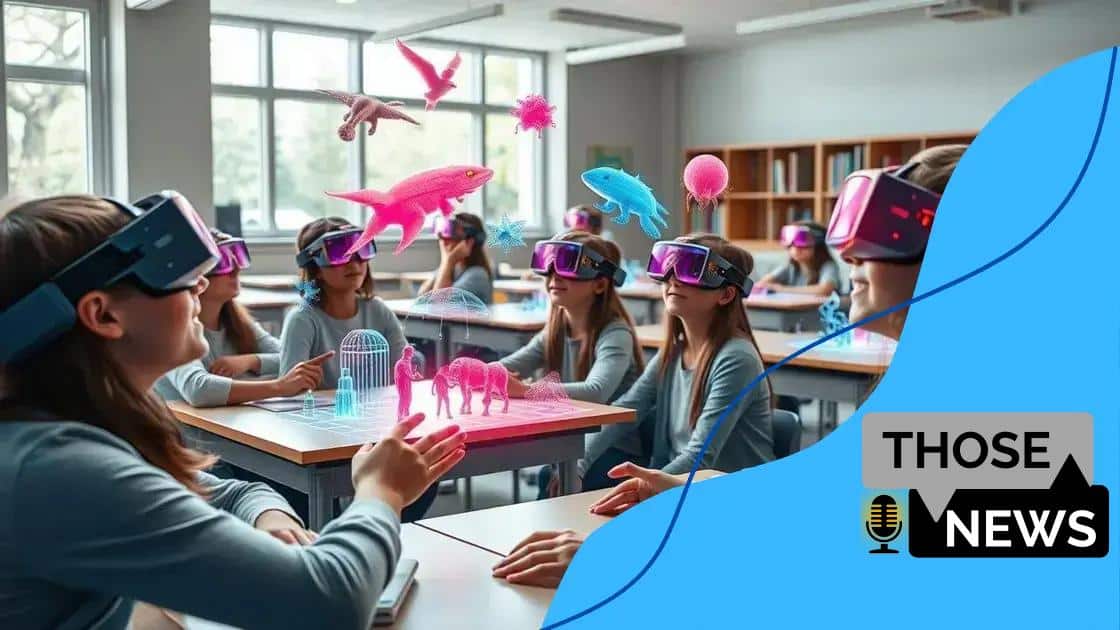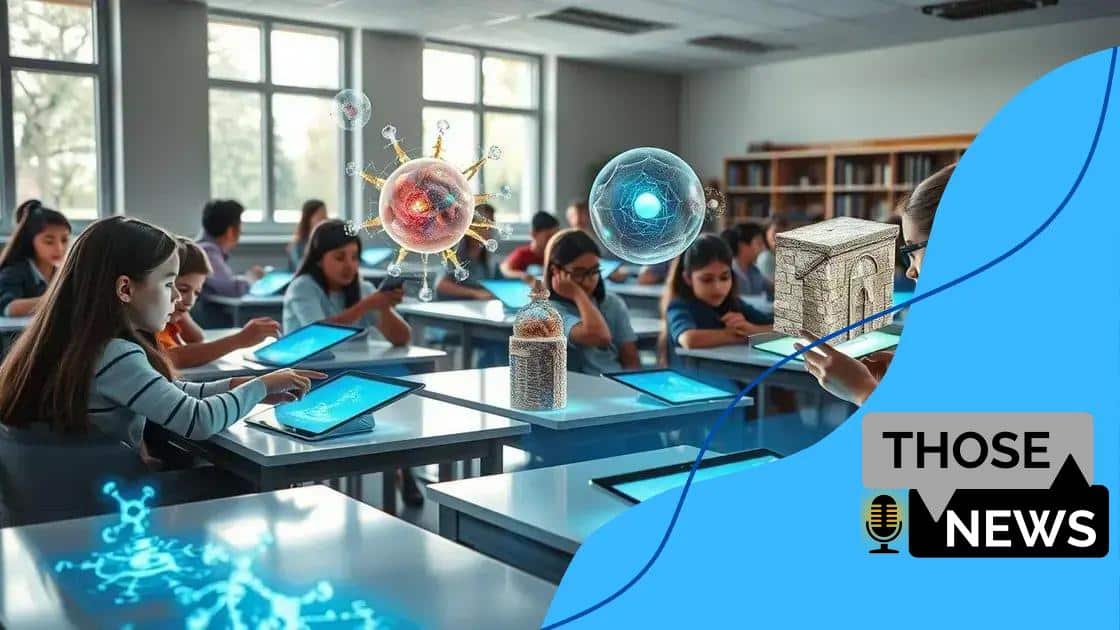How AR is being used for hands-on learning experiences

Augmented reality (AR) is transforming education by providing interactive, engaging, and immersive learning experiences, enabling students to visualize complex concepts and collaborate effectively in real-time.
How AR is being used for hands-on learning experiences is changing the way students grasp complex concepts. Imagine learning biology by exploring a 3D model of a human heart right in front of you. Curious about how this technology can enhance your learning? Let’s dive in!
What is augmented reality?
Augmented reality (AR) is a technology that overlays digital content onto the real world. This can be experienced through devices like smartphones or AR glasses. With AR, users can interact with 3D models or information that enhances their understanding of their surroundings.
One key feature of augmented reality is its ability to blend the physical and digital worlds seamlessly. For instance, during a science lesson, students can visualize molecular structures right on their desks. This immersive experience makes learning more engaging and effective.
How AR Works
AR combines the real environment with virtual elements. It uses technologies such as GPS, cameras, and sensors to detect the physical world and place digital content accordingly. As users move around, the AR content adjusts in real-time, providing a unique experience.
Common Uses of Augmented Reality
- Education: Teachers use AR to create interactive lessons that capture student attention.
- Healthcare: Medical students practice surgeries on virtual patients through AR simulations.
- Retail: Shoppers use AR apps to try on clothes or see how furniture fits in their homes before buying.
- Entertainment: Games like Pokémon GO enhance outdoor adventures with virtual creatures to catch.<\/li>
Through these applications, augmented reality proves to be a versatile tool across various fields. By enhancing the way we interact with information, AR drives engagement and promotes deeper understanding.
Benefits of AR in education
The benefits of AR in education are significant and can greatly enhance the learning experience for students. With AR, traditional lessons transform into interactive experiences, making learning more engaging and enjoyable. This technology offers a unique way for students to visualize complex concepts, leading to better understanding and retention.
By using augmented reality, educators can immerse students in rich, virtual environments. This not only captures their interest but also promotes active participation in classroom activities. Studies show that when students are actively involved in learning, they are more likely to grasp challenging subjects.
Enhanced Engagement
AR creates compelling learning experiences. Students who use AR are often more motivated to participate. They can explore 3D models, animations, and simulations related to their subjects. For instance, they can take virtual field trips to historical sites or conduct experiments in a simulated lab without any risks.
Improved Understanding
With augmented reality, abstract concepts become tangible. Visualizing data and content helps students better grasp topics that would otherwise be difficult to understand. For example, learning about the solar system can be transformed into a 3D journey through space, making the experience memorable.
- Personalized Learning: AR can be tailored to meet individual learning speeds and styles, ensuring that each student receives the attention needed.
- Collaboration: Students can work together in AR environments, fostering teamwork and communication skills.
- Instant Feedback: With interactive AR applications, students receive immediate responses to their actions, helping them make corrections and improve.
- Accessibility: AR can bridge gaps for students with disabilities, providing alternative methods of learning.
Overall, the integration of augmented reality into education leads to more dynamic and effective learning environments. By leveraging these tools, educators can create a more inclusive and impactful educational experience.
Examples of AR applications for hands-on learning

Many schools and institutions are now implementing augmented reality (AR) applications for hands-on learning. These applications provide students with unique experiences that transform traditional education into interactive exploration. Through AR, students can engage with learning material in a way that is both fun and educational.
For example, one popular AR application focuses on enhancing science education. Students can conduct virtual dissections using AR technologies. This allows them to explore the intricate anatomy of animals without the ethical concerns associated with real dissections. They can rotate, zoom in, and even see how the organs function in a 3D space, creating a deeper understanding of biological systems.
Popular AR Apps in Education
Several AR applications are making significant impacts in classrooms:
- Google Expeditions: This AR tool allows students to take virtual field trips around the world, exploring landmarks and historical sites.
- Merge Cube: Students can hold a cube in their hands and see various interactive 3D models come to life, from planets to ancient artifacts.
- Elements 4D: This app helps students learn chemistry concepts by visualizing different elements and their reactions in real-time.
- 8th Wall: Educators use this platform to create custom AR experiences tailored to their curriculum, fostering creativity and engagement.
In addition to these applications, AR also supports math learning by enabling students to visualize geometric shapes and solve problems using interactive tools. By manipulating digital shapes in 3D, learners can improve spatial reasoning skills.
Through the use of augmented reality, educators can enhance participation and make subjects more relatable. By integrating technology into lessons, students can explore, learn, and collaborate in exciting new ways.
Challenges in implementing AR in classrooms
Implementing augmented reality (AR) in classrooms comes with its own set of challenges. While the benefits are clear, educators must navigate various obstacles to successfully integrate this technology into their teaching methods. Understanding these challenges helps educators prepare for a smoother implementation.
One major challenge is the cost associated with augmented reality tools and devices. Not all schools have the budget to acquire the latest AR technology, which can limit access for some students. Additionally, ongoing costs for app subscriptions and updates can add to the financial burden.
Technical Issues
Another common issue is the technical skill gap among teachers and students. Not everyone is familiar with how to use AR technologies effectively. Teachers may need extra training to feel confident in using AR tools in their lessons. Furthermore, students also require guidance to navigate these new technologies.
Infrastructure Requirements
Classroom infrastructure can pose a challenge as well. AR applications often rely on high-speed internet and sufficient hardware, such as tablets or AR glasses. In some areas, schools may not have access to reliable internet service, which can hinder the use of AR.
- Hardware Limitations: The devices required for AR need to be capable and maintained regularly, which can be a challenge.
- Content Quality: Creating engaging and educational AR content is crucial, but it requires time and expertise.
- Student Distraction: With exciting technology, some students may get distracted and lose focus on learning objectives.
- Privacy Concerns: Using AR may involve data collection, raising questions about privacy and data protection.
Despite these challenges, overcoming them can lead to successful integration of augmented reality into education. With proper planning and support, schools can harness the power of AR to create enriching learning experiences.
The future of AR in educational experiences
The future of augmented reality (AR) in educational experiences looks bright and full of potential. As technology continues to evolve, AR is expected to become even more integrated into the classroom. Educators and students will have access to advanced tools that change the way learning occurs.
One significant trend is the increasing development of AR applications specifically tailored for various subjects. With more educational content available, teachers can create customized lessons that cater to their students’ needs. For instance, AR could offer interactive history lessons where students engage with historical events in immersive ways.
Expansion of AR Technologies
As AR headsets and mobile devices become more affordable, classrooms can adopt this technology more widely. This means that more students will have opportunities to experience hands-on learning through AR. Imagine a chemistry class where students can visualize molecules forming bonds in real-time!
Enhanced Collaboration
The future also holds promise for enhanced collaboration through AR. Students can work together on projects, sharing their unique perspectives while using AR tools to visualize their ideas. This fosters teamwork and improves communication skills, preparing them for the workforce.
- Personalized Learning: AR will enable tailored educational experiences based on individual student learning styles.
- Global Connections: Students can interact with peers around the world through AR, sharing diverse insights and cultures.
- Gamification: The integration of gaming elements in AR can make learning more motivating and engaging for students.
- Skill Development: AR will help students develop necessary skills such as problem-solving and critical thinking in an interactive environment.
As AR becomes more common in classrooms, it will empower students to take control of their learning journeys. The more engaging and interactive the learning experience, the better the retention and understanding of complex subjects.
FAQ – Frequently Asked Questions about Augmented Reality in Education
What is augmented reality (AR) in education?
Augmented reality (AR) in education refers to the use of technology to overlay digital information onto the real world, enhancing learning experiences.
How does AR improve student engagement?
AR improves engagement by making lessons interactive and immersive, allowing students to explore topics in a fun and dynamic way.
What are some challenges of implementing AR in classrooms?
Challenges include costs of technology, the need for teacher training, and ensuring reliable infrastructure like internet access.
What is the future of AR in education?
The future of AR in education includes increased integration, personalized learning experiences, and enhanced collaboration among students.





